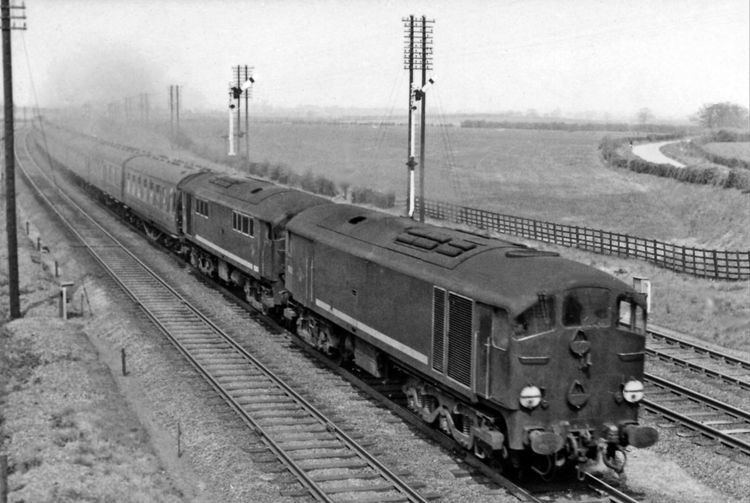Power type Diesel-electric Total produced 20 UIC class Co'Bo' | Build date 1958–1959 | |
 | ||
Builder | ||
The British Rail Class 28 (Metropolitan-Vickers Type 2) diesel locomotives, or 'Metrovicks' as they were popularly known, were built as part of the British Railways 1955 Modernisation Plan. The locomotives had a Co-Bo wheel arrangement (a 6-wheel bogie at one end, a 4-wheel bogie at the other) – unique in British Railways practice and uncommon in other countries, although Japan also used some C-B diesel hydraulics. This made maintenance more complicated. The maximum tractive effort of 50,000 lbf (220 kN) was unusually high for a Type 2 locomotive but, as there were five (not four) driving axles, the risk of wheelslip was minimal.
Contents
Engine
With low-speed Crossley 8-cylinder HST Vee8 two stroke engines, they represented an experiment in two stroke versus four stroke engines for diesel-electric traction.
The engines had exhaust pulse pressure charging and developed 1,200 horsepower (895 kW) at 625 rpm. There were no valves, and inlet and exhaust were via ports in the cylinder walls. The same engine was originally fitted in the Irish A Class and the Western Australian Government Railways X class. A similar, but smaller engine, the ESNT6 was used in the D3/3 shunters, an 08 with a Crossley engine rather than English-Electric.
Almost from the beginning the Metrovick's Crossley engines were problematic. They suffered frequent failures and by 1961 the entire class was handed back to the manufacturer for remedial work on the engines and to cure problems with cab windows falling out while running. The cab windows were modified such that instead of wrapping round to the side the outer front windows were replaced by a flat piece of glass facing the front only.
The engines were also noisy and prone to unacceptable levels of smoky exhaust fumes.
Statistics
Total weight in working order was 97 long tons, distributed as shown in the table below. The units are tons, hundredweights and quarters.
Operation
All 20 were initially allocated to the Midland Division of BR's London Midland Region, where they were often used in pairs on the overnight London–Glasgow “Condor” express freight service. Later they were transferred to the Barrow-in-Furness area prior to withdrawal after only 11 years at work and in service.
Despite the locomotives being otherwise reliable the Crossley engines were still giving problems and British Rail considered replacing the engines, as was done with the Class 31 diesels and, later, with Crossley-engined locomotives in Ireland. Instead the entire class was withdrawn from service during 1967–68, and all but one were scrapped by the end of 1969. Their parts had been sold to make new metals by the end of 1971.
Preservation
A single locomotive, D5705, survived by historical accident, being renumbered S15705 and used from December 1968 by the Research Division for its Tribology Test train. It was superseded by a Class 24, and was used as carriage heating unit TDB968006 (based at Bath Road Depot, Bristol) before being preserved in 1980. It is currently on the East Lancashire Railway. The Class 15 Preservation Society has signed an agreement with the owners of D5705 to become its custodians during its restoration and operation for the next ten years, although funding will remain separate.
In fiction
The Class 28 is the basis for BoCo, a character in The Railway Series children's books by the Rev. W. Awdry and the spin-off TV series Thomas and Friends, he carries the number D5702.
Models
The Class 28 has been made as a 00 gauge model in several forms, including a ready-to-run version by Hornby Dublo. A ready to run model is being produced by Heljan on behalf of and exclusive to Hatton's Model Railways in Liverpool. The Silver Fox Models model has now been withdrawn.
